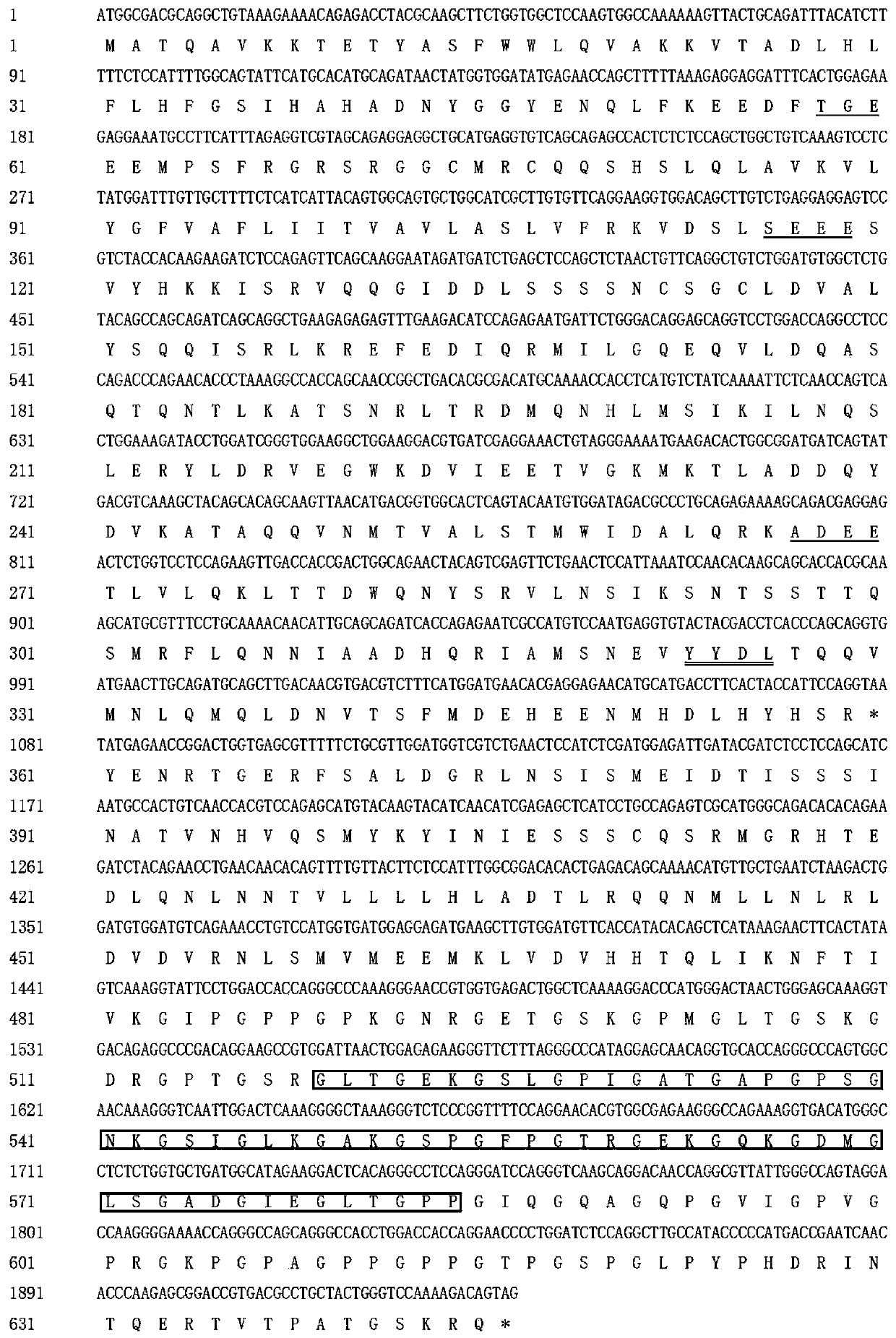Large yellow croaker scavenger receptor SCARA3 gene and application thereof
A scavenger receptor, large yellow croaker technology, applied in the field of genetic engineering, can solve the problems of economic loss, threat to large yellow croaker breeding, high mortality, etc., and achieve the effects of rapid response, reasonable design and convenient operation
- Summary
- Abstract
- Description
- Claims
- Application Information
AI Technical Summary
Problems solved by technology
Method used
Image
Examples
Embodiment 1
[0031] The complete ORF of the large yellow croaker scavenger receptor SCARA3 gene was obtained by the following method:
[0032] S1: Total RNA was extracted from the collected 8 tissue samples including liver, spleen, brain, heart, head kidney, muscle, skin, gills and intestine;
[0033] (1) Take 30mg of tissue samples in a 1.5mL centrifuge tube;
[0034] (2) Add 200 μL Trizol Regent to the centrifuge tube;
[0035] (3) Add 800 μL Trizol Regent after rapid and thorough grinding with an electric grinding rod;
[0036] (4) Blow and suck the precipitate repeatedly with a pipette gun to resuspend it, and place it at room temperature for 5 minutes;
[0037] (5) Add 200 μL of chloroform, cap the centrifuge tube tightly, shake vigorously by hand for 15 seconds, and place at room temperature for 10 minutes;
[0038] (6) Centrifuge at 12000×g for 15 minutes at 4°C to separate the solution into upper, middle and lower layers;
Embodiment 2
[0082] Tissue-specific distribution and expression of scavenger receptor SCARA3 gene in large yellow croaker
[0083] Firstly, 9 tissues of liver, spleen, brain, heart, head kidney, muscle, gills, intestine and skin of healthy large yellow croaker (body length 20-30cm, weight 350-400g) were taken, according to the sequencing of the scavenger receptor SCARA3 gene As a result, fluorescent quantitative PCR primers (as shown in Table 1) were designed, and qRT-PCR method was used to analyze the tissue differential expression distribution of SCARA3 gene in various tissues with large yellow croaker β-actin as an internal reference. The 20μL amplification reaction system is as follows:
[0084]
[0085] After mixing and centrifuging, they were placed on a fluorescent quantitative PCR instrument and amplified by a two-step method: pre-denaturation at 95°C for 4 minutes; denaturation at 95°C for 10 seconds, extension at 60°C for 45 seconds, 40 cycles, and finally extension at 72°C for ...
Embodiment 3
[0089] Expression of Scavenger Receptor SCARA3 Gene of Large Yellow Croaker in Infection of Vibrio harvelii
[0090] Experimental large yellow croakers (body length 20-30cm, body weight 350-400g) were kept temporarily in clean seawater at 25°C for 1 week, and fresh seawater was changed every day. Subsequently, the large yellow croakers were randomly divided into two groups, 30 in each group, and the experimental group was intraperitoneally injected with 100 μL of PBS-resuspended Vibrio harveylius (pH 7.4, 1×10 8 CFU / mL), the control group was injected with 100 μL PBS (pH 7.4). Six tissues of liver, spleen, brain, head kidney, muscle, and skin were collected at 0h, 2h, 6h, 12h, 24h, 48h, and 72h after injection, and total RNA was extracted. The expression levels of the large yellow croaker scavenger receptor SCARA3 gene at 0, 6, 12, 24, 48 and 72 hours after infection with Vibrio harveyi were detected by fluorescent quantitative PCR. The primers, reagents and methods used were...
PUM
 Login to View More
Login to View More Abstract
Description
Claims
Application Information
 Login to View More
Login to View More - R&D
- Intellectual Property
- Life Sciences
- Materials
- Tech Scout
- Unparalleled Data Quality
- Higher Quality Content
- 60% Fewer Hallucinations
Browse by: Latest US Patents, China's latest patents, Technical Efficacy Thesaurus, Application Domain, Technology Topic, Popular Technical Reports.
© 2025 PatSnap. All rights reserved.Legal|Privacy policy|Modern Slavery Act Transparency Statement|Sitemap|About US| Contact US: help@patsnap.com



